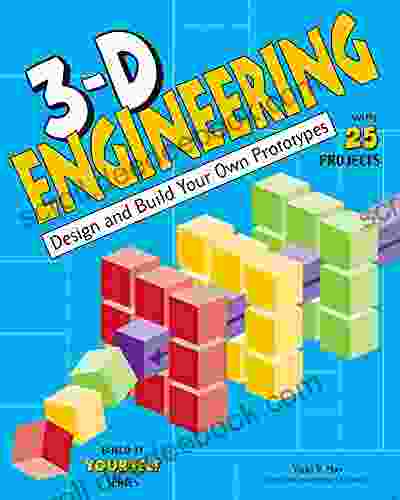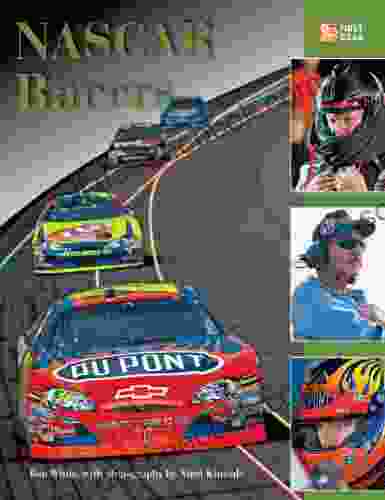Design and Build Your Own Prototypes: A Comprehensive Guide for DIY Enthusiasts

Prototyping is an essential step in the product development process. It allows you to test your ideas, validate your design, and get feedback from potential users. While there are many companies that can help you with prototyping, it's also possible to design and build your own prototypes at home.
This article will provide you with a comprehensive guide to designing and building your own prototypes. We'll cover everything from choosing the right materials to creating your first prototype.
The first step in designing a prototype is choosing the right materials. The materials you choose will depend on the nature of your product. For example, if you're building a prototype of a physical product, you'll need to choose materials that are durable and strong. If you're building a prototype of a software product, you'll need to choose materials that are easy to work with and modify.
4.8 out of 5
| Language | : | English |
| File size | : | 19441 KB |
| Text-to-Speech | : | Enabled |
| Enhanced typesetting | : | Enabled |
| Word Wise | : | Enabled |
| Lending | : | Enabled |
| Print length | : | 128 pages |
| Screen Reader | : | Supported |
Here are some of the most common materials used for prototyping:
- Cardboard is a great material for prototyping because it's inexpensive, easy to work with, and lightweight. It's also a good choice for rapid prototyping, as you can quickly create and modify prototypes without having to spend a lot of time or money.
- Foam board is another inexpensive and easy-to-work-with material that's perfect for prototyping. It's also very lightweight, making it a good choice for prototypes that need to be transported or stored easily.
- Plastic is a more durable material than cardboard or foam board, but it's also more expensive and difficult to work with. Plastic is a good choice for prototypes that need to be strong and durable.
- Metal is the most durable material for prototyping, but it's also the most expensive and difficult to work with. Metal is a good choice for prototypes that need to be able to withstand high temperatures or forces.
Once you've chosen the right materials, you can start creating your first prototype. The best way to start is to make a simple sketch of your product. This will help you to visualize your product and determine what materials you need.
Once you have a sketch, you can start building your prototype. The best way to do this is to start with a small, simple prototype and gradually add more features and complexity. This will help you to avoid getting overwhelmed and make it easier to identify and fix errors.
As you build your prototype, be sure to test it frequently. This will help you to ensure that your prototype is working as intended and that it's meeting your needs. If you find any problems with your prototype, be sure to make changes and test it again until it's working properly.
Once you have a working prototype, it's time to get feedback from potential users. This is a critical step in the product development process, as it will help you to identify any areas that need improvement.
There are many ways to get feedback on your prototype. You can ask friends and family to test it out, or you can post it online and ask for feedback from other users. You can also attend trade shows or other industry events and get feedback from potential customers.
When you're getting feedback on your prototype, be sure to listen carefully to what people have to say. Don't be afraid to ask questions and get clarification on their feedback. The more feedback you get, the better you'll be able to improve your prototype.
Prototyping is an essential step in the product development process. It allows you to test your ideas, validate your design, and get feedback from potential users. While there are many companies that can help you with prototyping, it's also possible to design and build your own prototypes at home.
By following the steps outlined in this article, you can create your own prototypes and take your product development to the next level.
4.8 out of 5
| Language | : | English |
| File size | : | 19441 KB |
| Text-to-Speech | : | Enabled |
| Enhanced typesetting | : | Enabled |
| Word Wise | : | Enabled |
| Lending | : | Enabled |
| Print length | : | 128 pages |
| Screen Reader | : | Supported |
Do you want to contribute by writing guest posts on this blog?
Please contact us and send us a resume of previous articles that you have written.
 Novel
Novel Page
Page Story
Story Genre
Genre Library
Library Newspaper
Newspaper Bookmark
Bookmark Glossary
Glossary Manuscript
Manuscript Scroll
Scroll Codex
Codex Bestseller
Bestseller Classics
Classics Library card
Library card Narrative
Narrative Memoir
Memoir Reference
Reference Character
Character Resolution
Resolution Librarian
Librarian Catalog
Catalog Card Catalog
Card Catalog Stacks
Stacks Archives
Archives Study
Study Research
Research Scholarly
Scholarly Lending
Lending Reserve
Reserve Academic
Academic Journals
Journals Rare Books
Rare Books Special Collections
Special Collections Dissertation
Dissertation Storytelling
Storytelling Awards
Awards Reading List
Reading List Book Club
Book Club Theory
Theory Textbooks
Textbooks Louise Candlish
Louise Candlish Peter S Hechl
Peter S Hechl Shirley H Wray
Shirley H Wray Destiny Skai
Destiny Skai Katie Hornor
Katie Hornor R Bick Lesser
R Bick Lesser Ame Ai
Ame Ai Jenny Edwards
Jenny Edwards T Ryle Dwyer
T Ryle Dwyer Thomas O Haakenson
Thomas O Haakenson Theodore O Johnson
Theodore O Johnson Amanda Oosthuizen
Amanda Oosthuizen Mollie Schmidt
Mollie Schmidt P J Wesley
P J Wesley Gabrielle G
Gabrielle G William H Gass
William H Gass Uma Krishnaswami
Uma Krishnaswami Samantha Lind
Samantha Lind Eric D Rosenberg
Eric D Rosenberg Candace Cotton
Candace Cotton
Light bulbAdvertise smarter! Our strategic ad space ensures maximum exposure. Reserve your spot today!

 Mario SimmonsPolitical Culture in the Early People's Republic of China: A Comprehensive...
Mario SimmonsPolitical Culture in the Early People's Republic of China: A Comprehensive... Ross NelsonFollow ·16.6k
Ross NelsonFollow ·16.6k Calvin FisherFollow ·7.5k
Calvin FisherFollow ·7.5k Jacob HayesFollow ·16.7k
Jacob HayesFollow ·16.7k Kyle PowellFollow ·19k
Kyle PowellFollow ·19k Russell MitchellFollow ·17.6k
Russell MitchellFollow ·17.6k Jackson HayesFollow ·5.6k
Jackson HayesFollow ·5.6k Austin FordFollow ·7.1k
Austin FordFollow ·7.1k Art MitchellFollow ·6k
Art MitchellFollow ·6k

 Howard Powell
Howard PowellDk Workbooks Science Third Grade: An In-Depth Exploration...
Science education plays a...

 Everett Bell
Everett BellLearn to Play Bluegrass Dobro Guitar: A Comprehensive...
: Bluegrass Dobro, A Story of...

 Jeffrey Cox
Jeffrey CoxHow the Raccoon Got His Mask
The raccoon, with its...

 George Bell
George BellHannah Meets Ruby Hannah Out West: An Adventure-Filled...
Hannah Meets...
4.8 out of 5
| Language | : | English |
| File size | : | 19441 KB |
| Text-to-Speech | : | Enabled |
| Enhanced typesetting | : | Enabled |
| Word Wise | : | Enabled |
| Lending | : | Enabled |
| Print length | : | 128 pages |
| Screen Reader | : | Supported |














